Written by Caitlin Stamm
This month commemorates the 25th anniversary of the Americans with Disabilities Act of 1990 (ADA), which ensures and protects the civil rights of people with physical and mental disabilities. In honor of this important legislation, we are celebrating the work of Illinois’s Disabilities Rehabilition-Education Services (DRES). The records that the U of I Archives holds on DRES and its work was processed and selectively digitized in 2008-2009, thanks to funding from the University of Illinois President’s office and support from B. Joseph White.
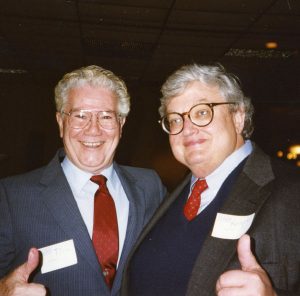
DRES, a groundbreaking institution that provides resources, therapies, and advocacy for students with disabilities, was founded by Timothy Nugent, an internationally recognized professor, lecturer, and advocate for disability resources and scholarship.[1]
DRES transformed the community of Champaign-Urbana; the accommodations made and supported by DRES allowed students with disabilities to participate as full members of the University—in classes, student groups, and athletics—benefiting both the whole student body and the University. [2]
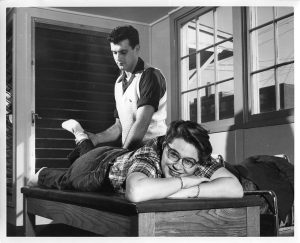
The journey to bring DRES to campus began in 1947, as many veterans with disabilities were returning from World War II. A deputy commander of the American Legion wrote to U of I President George Stoddard. DRES was founded at the University of Illinois Galesburg campus, which opened to support the influx of veterans coming to campus under the GI Bill. Previously a hospital, the facilities at Galesburg were suited to DRES’s needs. At the Galesburg campus, students’ therapies included bowling, swimming, and basketball. [3]
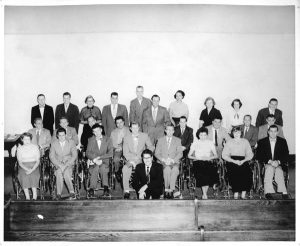
By 1948, the Delta Sigma Omicron Rehabilitation Service Fraternity (DSO) was founded. Its first members were mostly veterans, as well as one female student. Because Delta Sigma Omicron is a “coeducational service fraternity,” members are able to join other fraternities and sororities, as well as other professional and social organizations. Its annual publication, Sigma Signs (still in production today), was distributed internationally. It showed the achievements and activities of students with disabilities; it acted as a motivator for younger people, both with disabilities and without, and encouraged positive awareness and publicity.
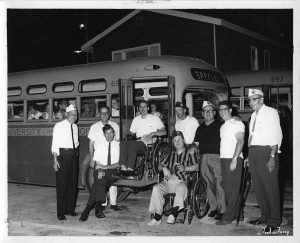
When the Galesburg campus was slated for closure in 1949, Tim Nugent went with students to the Illinois State Capitol, which brought attention and support. Students with disabilities petitioned to attend classes at the Urbana-Champaign campus. The students demonstrated to administrators that they could find their way around campus, using makeshift ramps to make their point. This petition was successful and the move to Main Campus brought wheelchair ramps and more publicity. [4] The popularity of the Rehabilitation-Education program grew, as students with polio and veterans from the Korean War flocked to campus for its services.
Students faced a number of obstacles, one of which was transportation to campus. Until 1950, students participated in pick-up and drop-off car pools, but in 1952, the “Blue Bulls”, two buses fitted with hydraulic lifts, were introduced to the campus. These buses were frequently updated and replaced as new technologies were made available, but the name stuck.
By 1955, the efforts of the first students in the program paid off; the University mandated that all new construction would accommodate students with disabilities and DRES was officially added to the University’s budget. In 1966, a new Rehab Center was dedicated. The building housed staff and contained therapy facilities and support offices.
—–
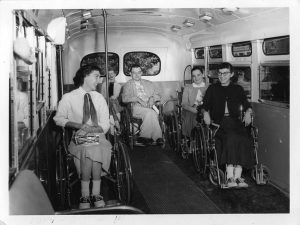
In addition to the beneficial services, therapies, and activities that the Division of Rehabilitation-Education Services provides, DRES has also been an important source of research and scholarship. The research performed at and by DRES has been valuable in making life more productive, efficient, and enjoyable for people with disabilities. Many of the modifications and accommodations researched and supported by DRES have become standards in creating accommodating spaces for people with disabilities.
Because of its tradition for excellent service and research, the University headed research for the development of the American National Standards Institute (ANSI) Standards A117.1, which serve as the national accessibility standards in the United States.
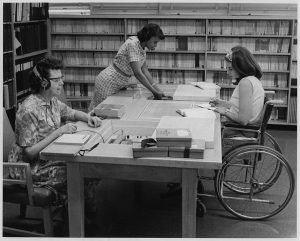
Many of the ideas this research produced may seem obvious today, but were revolutionary in the 1960s. Tim Nugent and his staff developed standards for things like accessible restrooms, doorways, and corridors, and layouts for drinking fountains, curbs, desks, and telephones. Standards were developed for offices, “public buildings, sidewalks, theaters, arenas, and railway stations”, kitchens and homes, and covered every feature a person might need during the day. [5] These standards ensure people with disabilities can live independently, enriching both their lives and the lives of their communities.
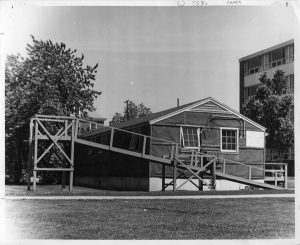
The research performed at DRES was (and is) designed to eradicate many of the myths and stigmas surrounding disabilities. For example, Nugent enlisted participants for studies in how wheelchair users expend energy while using wheelchairs and how safe drivers with disabilities are. [6] Importantly, DRES itself stood as a testament to the value and importance of extracurricular activities in supporting students’ lives and educations. The research that DRES produced was inspired by the active lives that its students were living.
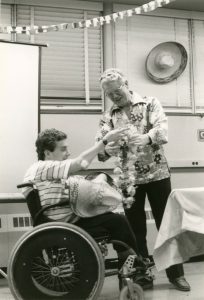
DRES also inspired research and education in other departments and colleges on the University campus. Students in engineering and occupational therapy, for example, would meet at DRES to talk to staff and students about their concerns and needs and Rehab Center staff taught courses. [7]
Professor Nugent retired in 1985, but the important work he pioneered with DRES at the University of Illinois continues today.
——-
Thanks to the support of B Joseph White and the President’s Office, more information on the history of DRES is available in an exhibit on our Guide to Disability Research Resources.
For more information on the current work that DRES is doing, please see www.disability.illinois.edu
Check back later this week for a post on the Gizz Kids, the U of I’s athletic program for students with disabilities.
[1] RS 16/6/20
[2] The News Gazette, October 27, 1965.
[3]-[7] Expanding Horizons. 1998.